#grinner
Explore tagged Tumblr posts
Text



some spooky transparent beanss
#halloween#grinner#scream#mummy#ghost#ghoul#spooky#transparent png#my edit#my beanies#beanie boos#plushies#kidcore
20 notes
·
View notes
Text

You look lovely with a smile
8 notes
·
View notes
Text
Warframe Tyl Regor + Manic
自己的設定上女Tyl Regor研發出來的Manic全都變成肥肥的圓球,雖然變成滾動才能移動,但機動性不減,而且因為身體變得柔軟和具有彈性,變得更抗打。

5 notes
·
View notes
Text
Grinner moments that are fucking wrecking me right now in no particular chronological order:
When Connor is abducted and separated from Locust but is so in tune with him that he can sense how close he is and uses that to orchestrate his escape
Challenging Death
The rest of Locust's species making cameo appearances and scaring the shit out of Connor
"I won't kid myself by saying I'm a hero or even a vigilante. I have to kill them or they'll go on to do worse things. How I feel about it is irrelevant, but I'd be lying if I said I didn't enjoy it."
Locust wiping an entire settlement off the map that one time
3 notes
·
View notes
Note
Hai ray did u know I am the smiling grinner and I am smiling and grinning at you like this

Hai
hi alan did you know that i

hi <3
5 notes
·
View notes
Text

4 notes
·
View notes
Text
I don't think I created Locust with the intention of making him the most romantic monster there ever was and yet here we are with him stroking Connor's hair like a pet and calling him "my love" in every conversation
#grinner#Connor#locust#i guess it's character development for him bc he usually prefers to keep his distance from humans unless he's killing them
0 notes
Text
I haven't, personally, but I can ask some of my friends!
HAS ANYBODY ELSE BEEN SEEING A SHADOW IN AN ORANGE SUIT?
8 notes
·
View notes
Text

kofi sketch comm for @deathshamble :}
#anthro#furry#sketch#commission#the smiling grinner ^^^#woooo give it up for red and black!!!!!#eyestrain
832 notes
·
View notes
Text

today's beanie: grinner the ghoul (beanie boo, 2018)
#plush#kidcore#ty#my beanies#plushie#today's beanie#hes so proud of his lil bag :)#grinner#beanie boos#ghost#halloween
11 notes
·
View notes
Text
Frowner has been sentenced to pressing buttons WITHOUT reward
8 notes
·
View notes
Text


#the origin of The Smiling Grinner Knows The World's His Dinner#for me‚ at least. this post on the original run of the dex was the first time i had ever heard that phrase#since everybody commented it#wailmer#bald#not bald. it has eyes up there. and a nose#and it's SPHERICAL!!!#SPHERICAL !!!!!
92 notes
·
View notes
Text
Wet Beast Wednesday: parrotfish
Which fish hangs out on a mermaid pirate's shoulder and repeats what she says in a high-pitched voice? The parrotfish, of course. Or at least in fiction they should (certainly will in my D&D world). But even in real life, parrotfish are still pretty interesting.
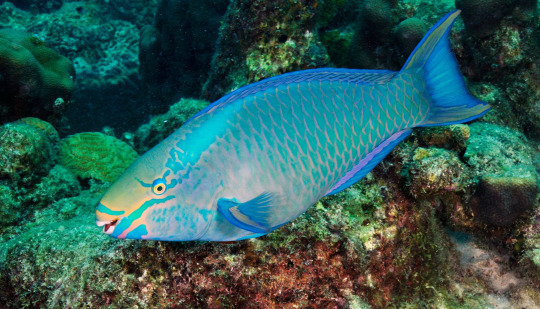
(Image: a common parrotfish (Scarus psittacus) seen from the side in front of rocks and corals. It is a brightly-colored fish, mainly light blue but with patches and stripes of yellow and pink on the fins. Its mouth is open, revealing what appears to be a beak. End ID)
Parrotfish are fish famous for their mouths and eating habits. There are about 90 species known. While they were historically considered their own taxonomic family, they have since been reclassified a subset of the wrasse family and there is still some debate on how to classify them. Most species are on the smaller size, but a few can get very large. The largest species is the green humphead parrotfish (Bolbometopon muricatum) at 1.5 meters (4.9 ft) and 75 kg (165 lbs) while the smallest species is the bluelip parrotfish (Cryptotomus roseus) reaching 13 cm (5 in). I could not find an average weight for the bluelips. What makes parrotfish really stand out visually is their colors and their mouths. Most species are very brightly colored, with distinct markings and males are usually more brightly colored than females. Their mouths are dominated by what appear to be beaks, which gave them their common name. These beaks are actually made of approximately 1,000 teeth arranged in 15 rows. As the teeth wear out, they drop off and are replaced by the row behind them. The teeth are made of fluorapatite, the second hardest biomineral int the world. To support their hardness, the fluorapatite crystals that make up the teeth are woven together in a structure very similar to chainmail, resulting in very hard teeth that measure in at a 5 on the Mohs scale of hardness. For reference, iron is a 4 and higher numbers are harder. The teeth can also handle 530 tons of pressure. You could put the weight of 200 black rhinos on a tooth and it would be fine. The beaks are powerful enough to bite through rock. Which is what they use it for, but more on that below. Another unusual feature of parrotfish is how they sleep. Some species make their own sleeping bags, which would be adorable if they weren't made of mucus. The mucus is produced using glands in the gills and looks like a transparent bubble. The fish sleeps in the mucus cocoon and when it wakes up, it eats the cocoon. There have been several proposed benefits of the cocoon. It contains chemicals that harm skin parasites while also providing a barrier that keeps new parasites from reaching the fish. It also likely blocks the fish's scent, helping it hide from predators.
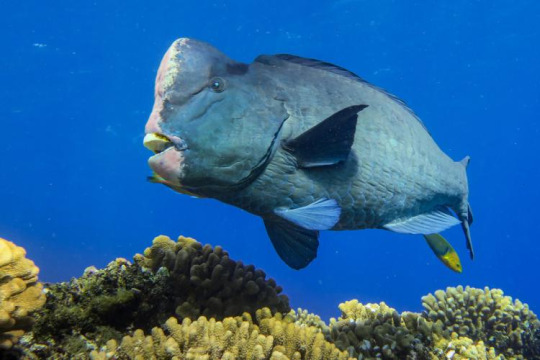
(Image: a green humphead parrotfish (Bolbometopon muricatum) swimming over yellow coral. It is large and mostly a uniform green color, except for the front of its head, which is pink. It has a large, fleshy lump on the top of its head. End ID)
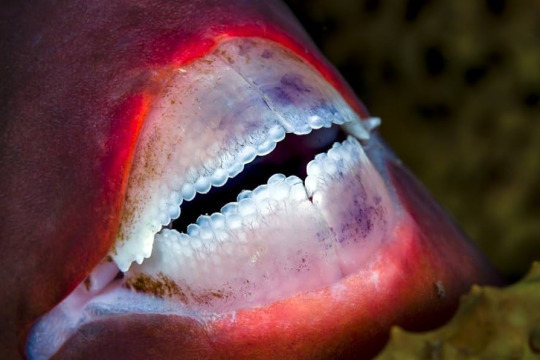
(Image: a close-up of a parrotfish's beak. The top and bottom beaks are divided into two halves, left and right. The beak is bade of small, circular teeth that overlap each other. End ID)
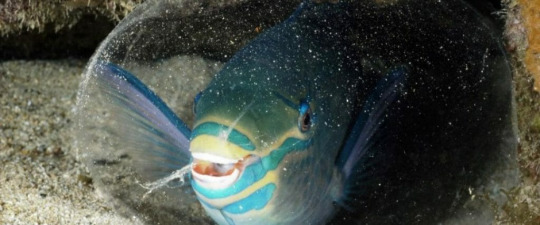
(Image: another common parrotfish seen from the front. It is inside of a mucus cocoon, which appears as a transparent bubble around the fish. Bits of sand dot the cocoon's surface. End ID)
Parrotfish live worldwide, though the majority of species are found in the Indo-Pacific. They live in warm, shallow waters with lots of rocky reefs, especially coral reefs. They use those powerful teeth to eat and what they eat most is algae. There are three main types of feeding behavior: excavating, scraping, and browsing. Excavators bite into rocks to get their food, scrapers crape food off of the surface of the rocks, and browsers go after larger food sources like seagrass and sponges. Some of the larger parrotfish species also make coral a large part of their diet. When they eat, they naturally get rock in their mouths, moreso in excavators. Because their food clings to the rock, spitting the rocks out would deny them food. Instead, parrotfish use pharyngeal teeth set in their throats to grind the rock into sand, which then passes through the digestive tract. When it exists the digestive tract, it is in the form of fine grains of rock. Or to put it another way, parrotfish eat rock and poop sand. A single parrotfish can produce up to 40 kg (88lbs) of sand yearly, and bigger species can produce even more than that. The process of rock being broken down by living things is called bioerosion and parrotfish are one of the most famous sources of bioerosion. The sand they produce can serve as the basis for new growth of coral or other species and helps reinforce nearby islands. In places like Hawai'i, the Caribbean, and the Maldives, it's estimated that up to 80% of the famous white sand is produced by parrotfish and they serve as a major source of incoming earth to support the islands. This makes parrotfish ecosystem engineers. Their eating of algae is also majorly important to their ecosystems. Algae can overgrow and smother delicate ecosystems like coral reefs and seagrass beds and decaying algae draws oxygen out of the water. Parrotfish help the health of their environments by keeping the algae population at healthy levels. Parrotfish also eat seaweeds and sponges that grow much faster than coral and can smother coral reefs. Parrotfish are considered keystone species in many reefs, including the great barrier reef and their population dropping correlates with reduced health of reefs. Damaged reefs tent to have larger parrotfish populations and those populations drop as the reef recovers.
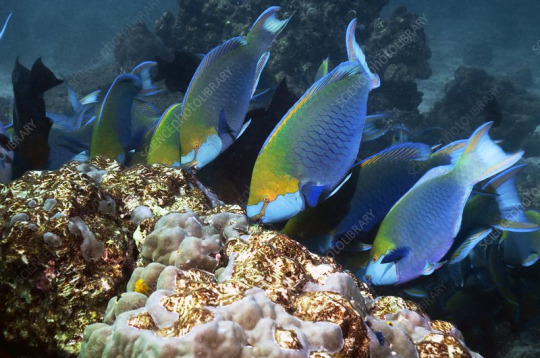
(Image: a group of many parrotfish feeding on coral. They are all the same species and are mostly blue, with yellow heads and stripes on the face. They appear to be biting the the coral. End ID)
Parrotfish are protogynous sequential hermaprodites. This means that all parrotfish are born female and can become male later in life. The transition is usually triggered when there are too many females or not enough males in a location, though in some species any fish that reaches a certain size will become male. Some parrotfish are solitary while others are social. In social species, the social groups consist of a large male and a harem of females that he protects and claims mating rights with. Other males will attempt to fight the male for dominance via headbutting and threat displays and occasionally one of his harem members will become male to challenge him. Males are usually more colorful than females, which they use to woo females, but also puts them at greater risk of predation. If the harem leader dies and is not replaces, one member of the harem will transition to male and replace him. Many species perform courtship dances during nights of the full moon. In non-social species, males will perform displays and fight with each other to attract females. In social species, the dominant male will mate with his harem while smaller males without harems will try to sneakily woo claimed females or sneak in and mate without being noticed. Parrotfish are broadcast spawners. The female releases her eggs into the water and the males releases sperm to fertilize them. The eggs will drift on the current until settling, after which the larvae will hatch. As with most fish species, only a very few of the larvae will reach adulthood.
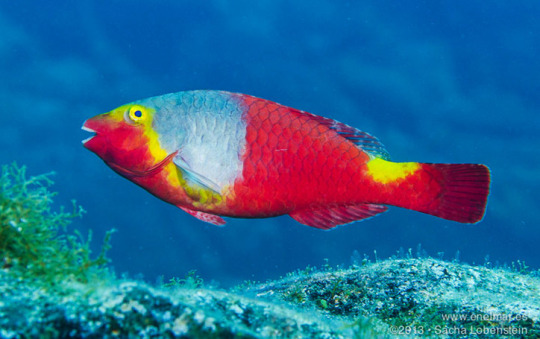
(Image: a Mediterranean parrotfish (Sparisoma cretense). It is mostly bright red, but with a yellow patch above the tail and a yellow stripe around the eye that runs down to the belly. A large patch behind the eye is blue. End ID)
Thankfully, most parrotfish species are not particularly endangered. The largest threat to them comes from habitat loss as pollution and climate change harms coral reefs. Reintroducing parrotfish to damaged reefs helps them recover. All species are edible, though there is no commercial fishery for them. While parrotfish are capable of delivering powerful bites, there are few reports of humans getting bit. That being said, I found one case where someone had skin on his penis bitten off by a parrotfish. And yes, that link has pictures. Enjoy.
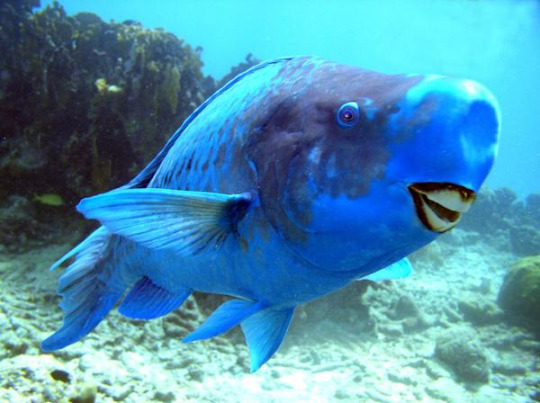
(Image: a blue parrotfish (Scarus coeruleus) looking at the camera. It is a blue fish with darker patches around the eye. Its snout is bulbous and the beak points downward. End ID).
#wet beast wednesday#parrotfish#the smiling grinner#fish#fishblr#fishposting#marine biology#biology#zoology#ecology#animal facts#coral reef#penile trauma#that's a wild tag to have on a post about fish#informative#image described
382 notes
·
View notes
Text
Oh to be loved by a creature older than humanity who wants to share immortality with you but is willing to become mortal as an alternative
#murderman posts#grinner#locust#this was supposed to be just a slasher concept#when did it become such a beautiful romance
0 notes
Text

the 3 varieties of siffrin
#siffrin#siffrin isat#in stars and time#my art#phenotypes...#idk this is just how i tend to draw them. i coudnt get gleeful grinner down today
126 notes
·
View notes